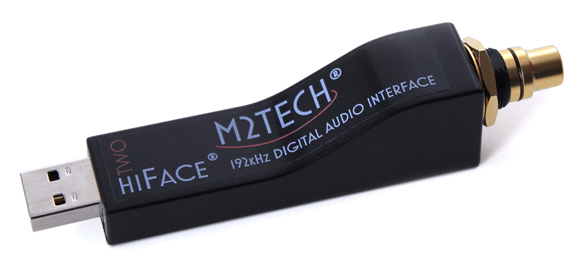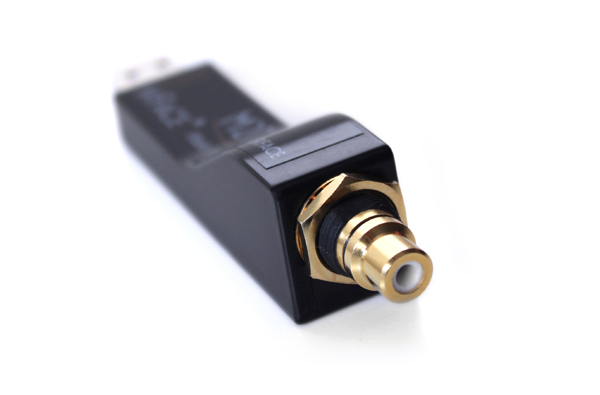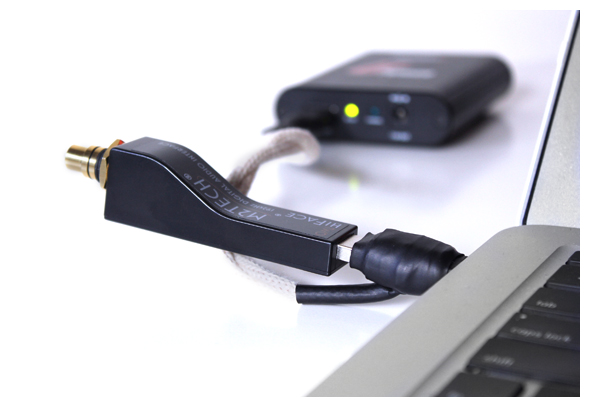M2TECH hiFace Two
 A lot can happen in two years in the world of digital audio. Back in early 2010, USB-to-S/PDIF converters for the masses were a bleeding-edge concern. Italy’s M2TECH changed all that when it introduced the hiFace, a $185 digital-audio interface not much larger than a standard USB thumb drive. This nifty little device transforms one’s computer into a digital-audio transport by giving users a simple and seamless way to deliver high-resolution music files from their computer to their playback system. With the advent of the original hiFace, M2TECH effectively brought the benefits of USB data clocking out from the cold and into hands of computer audiophiles everywhere.
A lot can happen in two years in the world of digital audio. Back in early 2010, USB-to-S/PDIF converters for the masses were a bleeding-edge concern. Italy’s M2TECH changed all that when it introduced the hiFace, a $185 digital-audio interface not much larger than a standard USB thumb drive. This nifty little device transforms one’s computer into a digital-audio transport by giving users a simple and seamless way to deliver high-resolution music files from their computer to their playback system. With the advent of the original hiFace, M2TECH effectively brought the benefits of USB data clocking out from the cold and into hands of computer audiophiles everywhere.
Since then, the hiFace’s existence has been more than justified. The sonic performance of most budget USB DACs doesn’t even come close to that of the hiFace, when feeding it a steady S/PDIF diet. A comparison between many models offering a direct USB connection and the hiFace will unmask the direct USB as relatively lifeless and anemic. This is often the reason that newcomers to digital audio complain that their incoming computer rig doesn’t compete with their outgoing CD player. We call this jitter: timing errors in the digital data flow that, in this instance, aren’t corrected by the USB DAC—sometimes the USB DAC itself is what introduces these timing errors.
A few DAC manufacturers, including Lenehan Audio, Metrum Acoustics, Eastern Electric, have wised up to the inherent weaknesses of more-vanilla USB receiver chips and are now employing M2TECH’s USB technology in their newer models. Meanwhile, the number of USB-to-S/PDIF converters coming to market has expanded considerably in the past two years: Anedio, April Music, Bel Canto, Channel Islands Audio, Halide Design, Human Audio, KingRex, Lindemann, Musical Fidelity, Quad, SOtM and Wavelength Audio now all offer models around the $500 mark. M2TECH itself also offers an Evo version of the hiFace ($499) that can be tricked out with optional battery PSU ($499) and master clock ($499)—but purchasing all three of those units puts you in the financial territory of Empirical Audio’s beastly $1,299 Off-Ramp USB DAC.
The original hiFace’s wide user base can likely be attributed to its agreeable retail price. But clocking devices are as important as the DAC itself, particularly at the budget end of the DAC market, where sophisticated jitter-rejection circuits (found at the high-end) are precluded by the manufacturer’s intended street price. Adding a $1,500 USB converter to a $500 DAC might not make intuitive sense to many people—adding a $200 device does.
USB-to-S/PDIF converters don’t just convert one digital-transfer protocol to another. They seek to better clock the data and thus minimize jitter. Some take an axe to the detrimental effects of EMI/RFI by deploying improved power-supply regulation and galvanic isolation.
As 2010 tipped over into 2011, I recall the audible improvements brought by the original hiFace as being small: a shade more definition here, a little more soundstage focus there. It wasn’t until Ireland’s John Kenny infused the hiFace with battery power that this reviewer really sat up and took notice. Exposure to the Audiophilleo1 and Audiophilleo2 drove the need for a USB converter home, took it inside and made it a nice cup of tea.
Another annoyance with the original hiFace was its need for proprietary drivers, which introduced a small lag into the audio-playback chain that meant video would run slightly out of sync with audio and dialogue running through the hiFace. This was a deal-breaker for some users.
M2TECH has eliminated this issue with the hiFace Two. Based around an XMOS receiver chip, it complies with USB Audio Class 2.0 (UAC2) and therefore works with native-mode USB audio drivers. This allows plug-and-play operation for Windows, OS X and Linux operating systems. (As it’s not UAC2-compliant, Windows requires additional drivers to handle anything above 24/96.) Like its predecessor, the new hiFace Two parses data up to 24/192 with each sample rate family—44.1/88.2/176.4 and 48/96/192—which is handled by its own oscillator.
For the hiFace Two, M2TECH has moved the shell cover from white to black, held the recommended retail price at $185 (dropping the price of the original unit to $150) and made coaxial and BNC models available.
The thumb-drive sized unit is 10 cm long and suspends somewhat precariously when plugged into a vertically situated USB port on the back of a Mac mini. The connection to a MacBook Air’s horizontal USB port allows one’s shelf or desk to better support the hiFace Two’s 50-gram weight (as well as the additional weight of the coaxial cable). That said, neither host computer dropped audio due to physical conditions. Even the Mac mini held fast during the review period.
The Sound
Experience has taught me that one of the key signs of jitter minimization is bass propulsion and definition. Tonally, if a straight USB feed into the Audio-gd NFB-2.1 is a watercolor and the Audiophilleo is a portrait in oil, the hiFace Two paints somewhere between the two. That’s commensurate with its pricing, as it’ll run you less than half the cost of the Audiophilleo2 ($579). You get what you pay for and you pay for what you get.
Listening to this new model is reminiscent of spending a week or two with Musical Fidelity’s original V-LINK: a small improvement over the USB implementation found in the Peachtree iNova, but not as musically emphatic or engaging as Philip Gruebel’s little grey box. The Audiophilleo also scores another point over all the competition by negating the need for (and expense of) a digital coaxial cable.
Once you accept the halfway-house nature of the hiFace Two solution, the fun begins. Meandering through Leonard Cohen’s much-underrated 2001 “comeback” album, Ten New Songs, a sense of player space is more apparent with the new M2TECH device than without. Better clocking (i.e. less jitter) takes the listener deeper into the music. Even at this less-expensive end of the USB-converter market, improvements can be heard in terms of micro-dynamics and vitality—Cohen’s aging croak simply sounds more human.
Switching to something of an edgier ’80s mastering job with R.E.M.’s Green exposed an over-enthusiastic lower treble in brighter systems. This was easily dialed back, thanks to Hannes Fricke’s adjustable tweeter gain on his WLM La Scala floorstanders, but the titanium dome tweeter in a pair of (vintage) Celestion Ditton 11 required a more creative solution.
The Splitter Cable and the Battery
Elijah Audio’s $105 BPM (battery-powered module) splits the input to any USB device such that data and power are fed independently. The BPM cable nixes the 5-volt host computer feed and only allows the data to reach the piggybacking hiFace. For this review, I hooked the BPM’s 20-cm tail into KingRex’s rechargeable U Power Li-on battery module ($189).
Sonically, this amended hiFace setup took the music a step backwards into a pool of warm water, eradicating that lower-treble glare. In the context of digital-audio tweaks, this one rated as substantial—so much so that I had a friend stop by to corroborate my findings. He agreed that the BPM/U Power appendage massaged the tense shoulders from VCMG’s bleepy Aftermaths EP and Depeche Mode’s Violator.
Hearing the benefits of adding battery power to the hiFace Two, it’s easy to see how John Kenny arrived at doing the same for his all-in-one solution. So, with the cost of these modifications running past the $400 mark, why wouldn’t you just opt for his roughly $420 JKSPDIF USB-to-S/PDIF battery-powered converter? Two reasons: Linux compatibility and audio lag. The former will be of keen interest to Squeezebox Touch users who have installed the Enhanced Digital Output app, which it turns the USB input on the rear into a digital-audio output. But that’s a story for another day…
For the cash-strapped computer audiophile the hiFace Two is a suitably priced intermediary that will wipe away some jitter between you PC/Mac and budget DAC. -John Darko
M2TECH hiFace Two
MSRP: $185





